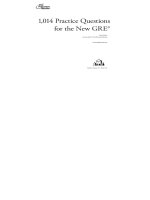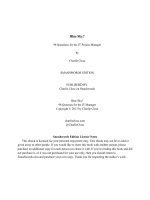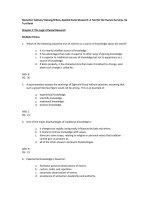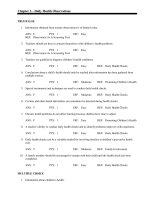PMP examination practice questions for the PMBOK guide, 5th edition
Bạn đang xem bản rút gọn của tài liệu. Xem và tải ngay bản đầy đủ của tài liệu tại đây (1.24 MB, 417 trang )
Copyright © 2014 Sean Whitaker
All rights reserved.
ISBN-13: 978-1497428300
ISBN-10: 1497428300
“PMI”, “PMP” and “PMBOK” are registered marks of Project Management Institute, Inc.
Introduction
Questions
Foundational Concepts
Project Integration Management
Project Scope Management
Project Time Management
Project Cost Management
Project Quality Management
Project Human Resource Management
Project Communications Management
Project Risk Management
Project Procurement Management
Project Stakeholder Management
Professional Ethics
Answers
Foundational Concepts
Project Integration Management
Project Scope Management
Project Time Management
Project Cost Management
Project Quality Management
Project Human Resource Management
Project Communications Management
Project Risk Management
Project Procurement Management
Project Stakeholder Management
Professional Ethics
Formulae to remember
About the Author
Introduction
Welcome, and congratulations!
You have either committed to taking the globe’s leading project management credential or are seriously
considering it. The PMI® Certification Program is recognized worldwide and PMI is the world’s
leading association relating to project management. Gaining the Project Management Professional
(PMP®) certification is a great way to prove your existing experience, gain insight into best practice
and advance your career prospects.
This book contains over 400 practice questions for the PMP® examination, based on the contents of the
PMBOK® Guide, 5th edition. They are meant to provide revision and preparation for when you decide
to sit the exam. It’s a difficult exam and you’ll need to make a significant investment in study time to
make sure you pass.
You can use this book in any way you want. You can work through each of the questions in sequence,
randomly pick ones from different chapters, or set yourself time limits to answer a particular set of
questions.
No set of practice question can fully replicate the real exam although we do try to get them as close as
possible.. Examination preparation questions, like these, are focused on a single knowledge area, while
many of the exam questions draw scenarios from several different process groups and knowledge
areas. Be prepared for this and study the inputs into each process and where they originate as outputs.
Additionally, study the outputs from each process and where they go as inputs. You will find outputs
from processes in one knowledge area become inputs in an entirely separate knowledge area.
Here are some other study tips to increase your chances of passing the exam:
1. Start by finding out how you best learn. Some people can only learn by taking notes, or by
reading and re-reading. You may learn better by drawing diagrams or by teaching to others. Visit
a website like www.vark-learn.com to figure out how you learn best.
2. Use mnemonics to help you remember things. Mnemonics are phrases or acronyms that can jog
your memory, like “In Summer The Cruel Queen Has Cold Runny Porridge Snacks.” The first
letter of each word stands for the ten knowledge areas in the PMBOK® Guide: Integration, Scope,
Time, Cost, Quality, Human Resource, Communications, Risk, Procurement and Stakeholder
Management. You can use this one if it helps, but they are usually more memorable if you make
up your own.
3. Plan your study well in advance and set aside time just for study. Stick to it. Life and work can
get in the way of your best laid plans, but if you miss a scheduled study time be sure to make it
up.
4. Teach the topic to someone, anyone! Teach it to your wife, husband, children, work colleagues,
family pet or stuffed toy. Simply verbalizing and trying to explain in your own words to someone
(or something else) will expose holes in your knowledge pretty fast.
5. Make games and puzzles of information that you have to learn. Write out processes on bits of
card and throw them on the floor and try to reassemble them in the correct order. There is a great
game waiting for you for free download on my website.
6. Draw mind maps that link important concepts in a logical fashion. There are a set of blank ones
for free download on my website.
7. Put together a study group of others aiming to sit the exam as well. Share ideas, experience and
knowledge.
8. Use a commercial training provider that has courses specifically designed to help you pass the
exam. I strongly recommend you look for aPMI Registered Education Provider Ò (R.E.P.) to
ensure you are getting a quality trainer. You can also check out my website or contact me to see
where I am running training courses.
9. Remember that although the PMBOK® Guide is still the best way to study for the exam, the
exam itself is not based on the PMBOK® Guide but on the PMP Examination Specification
Outline and so a book that covers all the material is much better than relying on the PMBOK®
Guide. So get a book to help you with your self-study - I recommend the PMP Training Kit and
PMP Rapid Review, both books I’ve written, and both available from all good book retailers.
10. Lock in an exam date. Nothing focusses your study like having a confirmed exam date. If you
don’t lock it in you may be a perpetual student.
Here are my 6 steps to help you answer the questions:
1.
Read the question fully!
2.
Reread the question!
3.
Eliminate any obviously wrong answers.
4.
Place the answers on a spectrum of most right to most wrong and choose the most right
one.
5.
Organize the answers in order of which would be done first to the one which would be
done last, choose the one you would do first.
6.
Guess! Leave no question unanswered.
For all the up to date PMP® examination eligibility, pricing and scheduling information please visit the
Project Management Institute website www.pmi.org.
Finally, it is important that if you get a question wrong, you understand why. Use the following sheet to
record the reason you got a question wrong. See if you can spot patterns or issues that need adjusting in
your test-taking technique.
With the benefit of hindsight I could have got more questions correct if I had…
Carefully read the entire question and made sure I understood what was being asked.
Carefully read all of the alternative answers provided and understood what each meant
before answering the question.
Eliminated the obviously wrong answers.
Had a thorough knowledge of the appropriate definitions from the PMBOK® Guide.
Had a working knowledge and understanding of the appropriate the relevant formula from
the PMBOK® Guide.
Double checked my mathematical working out before selecting an answer.
Answered the questions as per the PMBOK® Guide perspective instead of my own
perspective.
Reviewed how I answered tough questions after completing other related questions to see if
my memory was any better.
Had more time to complete the examination questions and didn’t rush to answer each
question.
Please visit my website for free games, tools and study aids you can
download to help you with your study. Here is the list of what you can
download for free
1. How to pass the PMP® exam guide
2. The PMBOK® Guide Process Mapping Game
3. PMP® Examination Domain Tasks Puzzle Game
4. PMBOK® Guide Blank Mind Maps
5. Key terms and definitions
6. Formulae to remember
Good luck!
www.seanwhitaker.com
P.S. please don’t hesitate to contact me with any questions, comments or feedback you may have. I’m
always happy to hear from you and talk about project management.
Questions
Foundational Concepts
Question 1: Your team is confused because they use terminology and words
in project communications that appear to be interchangeable, but other teams
treat them as though they have specific, unique meanings. How can your
team find out what the terms mean?
A. The best way to differentiate between similar project terms is to ask the
project sponsor
B. Direct your team to a defined and standardized glossary such as the
PMBOK® Guide
C. Have your project team vote on what definitions they would like to use for
common terms
D. Project management terms have different meanings in different countries,
so consult your nearest PMI community.
Question 2: You are delivering an introduction to project management
training session to new team members. One team members appears confused
about the exact definition of a project. What is the BEST definition of a
project?
A. A temporary endeavor undertaken to create a unique product, service or
result
B. A body of work constrained by finances and time
C. An organized effort of work by a team managed by a project manager
D. The ongoing management of a business enterprise to achieve profitability
Question 3: Your team seems confused about whether or not the work they
are doing meets the definition of a project. To help them understand the
difference between projectized and operational work you give them the
following examples. Which of the following is not an example of a project?
A. Designing a new software solution
B. Building a new house
C. Regularly achieving 3% growth on last year's sales figures
D. Implementing a new business process or procedure
Question 4: You are planning to sit the PMP® examination and as part of
your study are referring to the PMBOK® Guide for help defining the project
process groups. Which of the following is not one of the 5 process groups in
the PMBOK® Guide ?
A. Closing
B. Checking
C. Initiating
D. Executing
Question 5: You are the project manager on a project to develop a new piece
of customer management software for an external client. Through your
approved change control process you are considering a request to alter the
scope of the project. While considering the impact of the request upon the
project scope you must also consider the impact upon other areas of the
project such as quality, schedule, budget and risk. These other areas that you
are considering represent what to the project?
A. Opportunities
B. Constraints
C. Constrictions
D. Risks
Question 6: The process of continuously updating, improving and detailing a
project management plan, or parts of a project management plan, as more
specific information becomes available is known as what?
A. Iterative expectation management
B. Project life cycle
C. Continuous improvement
D. Progressive elaboration
Question 7: While delivering a presentation to senior management on the
ways in which portfolio management can help your organization achieve
strategic success you realize that not everyone in the room understands what
portfolio management is. Portfolio management is BEST defined as what?
A. A group of projects managed by a project director
B. A collection of projects grouped together to take advantage of effective
management to meet strategic business objectives
C. A group of related projects managed in a coordinated way
D. A collection of projects relating to a single business unit within an
organization
Question 8: A group of projects that must be managed in a coordinated
manner to ensure that common goals and potential resource conflicts are
managed effectively is known as what?
A. Program
B. Portfolio
C. PMO
D. Life Cycle
Question 9: The CEO of your organization is considering the strategic
reasons the company has for approving your project proposal. At times he
seems confused about what exactly a strategic consideration is. Which of the
following is not a strategic consideration for authorizing a project?
A. Strategic opportunity
B. Return on investment
C. Customer demand
D. Market demand
Question 10: The team, or function, assigned responsibility for the
centralized and coordinated management of projects within an organization is
known as what?
A. Project headquarters
B. Program management office
C. Project management office
D. War room
Question 11: Your organization has employed a person to head the PMO.
During your first meetings with them you are discussing the extent of their
roles and responsibilities to fully understand what tasks they will be
responsible for and those they won't be responsible for. Which of the
following is not a primary function of a project management office?
A. Providing a project manager with daily progress reports on a specific
project
B. Managing shared resources across several projects
C. Identifying and developing project management methodology, best
practices and standards
D. Coordinating communication across projects
Question 12: All of the following are points where projects can intersect
with operational activity at various points during the product life cycle
except?
A. During development of a new product
B. While monitoring and controlling
C. During improvements in operations
D. At closeout phases
Question 13: What is the best description of the relationship between project
management and organizational strategy?
A. Organizational strategy will ensure the projects are delivered successfully
due to the way in which it appoints a qualified project manager
B. Organizational strategy enables a project manager to provide appropriate
governance to the entire project life cycle.
C. Organizational strategy and project management don’t interact as one is
operational in nature and the other is project based
D. Organizational strategy should provide guidance and direction to project
management and project management should deliver organizational strategy
by successful project delivery
Question 14: Your team seems confused about roles and responsibilities in
the project that you are leading. They are particularly confused about your
role as project manager. How would you explain the primary purpose of your
role?
A. The person responsible for budget control
B. The person responsible for delivery of technical tasks
C. The person assigned by the performing organization to achieve the project
objectives
D. The person responsible for sharing resources among projects
Question 15: When using the PMBOK® Guide to help you define and carry
out processes on your project you notice that a very common input into
nearly all the processes is enterprise environmental factors. Which of the
following examples would not be considered an enterprise environmental
factors?
A. Government or industry standards or regulations
B. Political climate
C. Net present value of investment
D. Project management information systems
Question 16: You have volunteered your time to help your organizations
PMO carry out an assessment of your organization using the OPM3 tool.
What does OPM3 measure?
A. The interdependency of projects within a program of work
B. The level of variance between project management best practice and the
actual application
C. The ability of a project manager to successfully deliver a project
D. An organization's project management maturity level
Question 17: The internal and external environmental factors that both
surround and influence, and sometimes constrain, a project are known as
what?
A. Enterprise organizational assets
B. Environmental process assets
C. Environmental enterprise constraints
D. Enterprise environmental factors
Question 18: The collection of generally sequential and sometimes
overlapping project phases differentiated by a distinct work focus is known as
what?
A. Project management information systems
B. Project management methodology
C. Project management office
D. Project life cycle
Question 19: All of the following are basic characteristics of the project life
cycle except? ?
A. Closing the project
B. Checking the project work
C. Starting the project
D. Carrying out the project work
Question 20: Divisions within a project where extra control is needed to
effectively manage the completion of a major deliverable are commonly
known as what?
A. Phases
B. Stage gates
C. Decision trees
D. Sub-projects
Question 21: You are explaining to your project sponsor that the best
approach to managing your project will be a phase-to-phase relationship.
Which of the following is not an example of a phase-to-phase relationship?
A. Sequential
B. Overlapping
C. Iterative
D. Progressive
Question 22: You are the project manager working in an organization where
the functional manager, that some of your staff answer to when not working
on your project, controls the project budget and resource availability. This
type of organization is commonly referred to as what?
A. Projectized
B. Strong matrix
C. Functional
D. Weak matrix
Question 23: You work in an organization where staff members are grouped
according to their specialty such as production, engineering and accounting
and projects are generally undertaken within these respective groupings.
What is this type of organizational structure known as?
A. Projectized
B. Weak matrix
C. Strong matrix
D. Functional
Question 24: All of the following are examples of Organizational Process
Assets that can assist your project except?
A. Government regulations
B. Lessons learned from previous projects
C. A template for a work breakdown structure
D. Configuration management knowledge bases
Question 25: The process of determining which the PMBOK® Guide
processes are appropriate to use on your project and the appropriate degree of
rigor to be applied in any given project is known as what?
A. Customizing
B. Prudency
C. Tailoring
D. Standardization
Question 26: The process group consisting of those processes performed to
define a new project or a new phase of an existing project by obtaining
authorization to start the project or phase is known as what?
A. Closing
B. Executing
C. Initiating
D. Planning
Question 27: You are completing the work defined in the project
management plan to satisfy the project specifications. Which process group
would your activities fall under?
A. Monitoring and controlling
B. Planning
C. Initiating
D. Executing
Project Integration Management
Question 28: You are in the process of developing your project closure
checklist and selecting those items and actions that will need to be completed
to ensure your project is closed properly. A team members asks to help you
do this work and asks you how you know a project can be closed. A project
can be considered to be ended under all of the following conditions except?
A. When the project manager resigns
B. When the project objectives have been achieved
C. When the project is terminated because its objectives will not or cannot be
met
D. When the need for the project no longer exists
Question 29: During the preparation of the business case for your project
you outline and document several different compelling reasons why your
project should proceed. These reasons include the high ROI, delivering
strategic value and an increase in business value. What is the BEST definition
of business value?
A. The value of the tangible assets the company holds that can be liquidated
to provide working capital
B. The value added to the business by projects that are completed
successfully
C. The value of the total sum of all tangible and intangible elements of the
business
D. The value of all the projects that the company is currently completing
Question 30: You are explaining to your team that all change on your project
must be documented and assessed in relation to any extra costs incurred. This
is particularly important at what point in a project's time line?
A. At the beginning of the project
B. Towards the end of the project
C. During the project execution
D. It is equal throughout a project
Question 31: While studying towards the PMP® examination you are
memorizing the processes in the PMBOK® Guide. How many processes are
there in the Project Integration Management knowledge area in the PMBOK®
Guide?
A. 7
B. 5
C. 4
D. 6
Question 32: You are in involved in making choices about resource
allocation on your project, making trade-offs among competing objectives
and alternatives and managing the interdependencies among the different
project management knowledge areas. Of which the PMBOK® Guide
knowledge areas will it be most useful to have an in-depth understanding?
A. Develop Project Management Plan
B. Project Integration Management
C. Project Risk Management
D. Perform Integrated Change Control
Question 33: One of your team members has recently discovered the
PMBOK® Guide and is intent on doing a project using each and every
process, tool and technique. You take this team member aside and explain to
them that the knowledge and processes described in the PMBOK® Guide
should be applied in what way?
A. You should apply the project management knowledge, skills and required
processes in whatever order is appropriate and with varying degrees of rigor
to achieve the desired project performance
B. Rigorously and exactly as shown in the PMBOK® Guide
C. The PMBOK® Guide is only a guide and you should only apply the parts
you understand fully
D. You should apply all the different knowledge areas and processes to your
project at the level required to achieve project success
Question 34: You are newly appointed to a project and are currently reading
the project charter to gain an understanding of what is known about the
project at this point. The project charter should contain enough information to
do all of the following except?
A. Complete the WBS
B. Initiate the project
C. Describe the high level project scope
D. Appoint the project manager
Question 35: You have been called in to evaluate a project that is
experiencing some performance challenges. The team seems disorganized,
and when you ask to meet the project sponsor, the project manager replies
that she doesn't know who the sponsor is. She also shares with you that the
planned value (PV) is $20,000, earned value (EV) is $14,500 and actual cost
(AC) is $36,000. You decide that you should really go back to the beginning
and figure how this project got started. What document should you request?
A. The project plan
B. The project charter
C. The cost performance analysis and report
D. The project authorization memo
Question 36: You and your team are currently developing the project charter
and are looking for valuable inputs you can use to complete it. All of the
following are inputs in the Develop Project Charter process except?
A. Business case
B. Project management plan
C. Enterprise environmental factors
D. Project statement of work
Question 37: You have completed a business case and project charter for
your project and are presenting it to senior management for consideration and
approval. Which of the following have you included in this document?
A. The project management plan
B. A copy of the stakeholder register
C. Any blank templates your organization has to assist in completing the
project charter
D. A description of the expected market demand for the product of the
project
Question 38: There are many ways to describe the work to be done a project.
What is the high level narrative description of products or services to be
delivered by the project more commonly referred to as?
A. Project statement of work
B. Project scope statement
C. Project scope
D. Product scope description
Question 39: Which of the following is not a method you would expect to
see used in a business case to justify a project on financial grounds?
A. External rate of investment (ERI)
B. Return on investment (ROI)
C. Net present value (NPV)
D. Internal rate of return (IRR)









